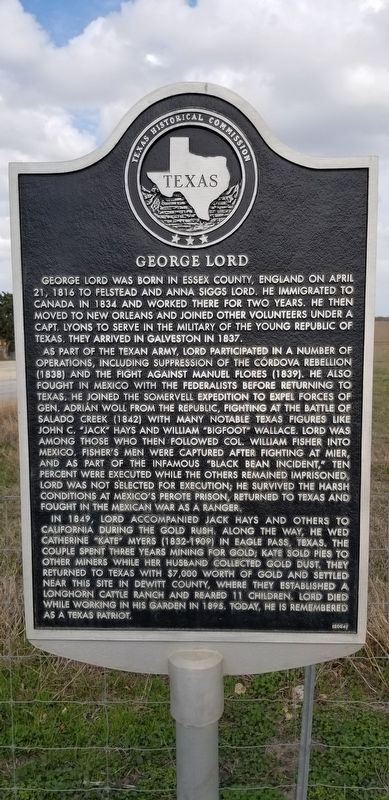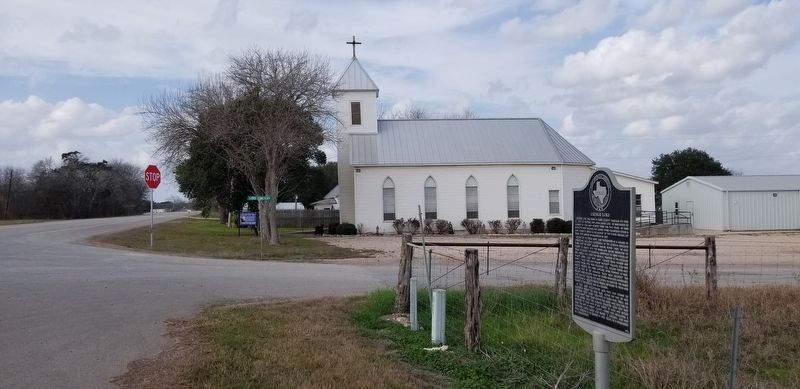Westhoff in DeWitt County, Texas — The American South (West South Central)
George Lord
George Lord was born in Essex County, England on April 21, 1816 to Felstead and Anna Siggs Lord. He immigrated to Canada in 1834 and worked there for two years. He then moved to New Orleans and joined other volunteers under a Capt. Lyons to serve in the military of the young Republic of Texas. They arrived in Galveston in 1837.
As part of the Texan Army, Lord participated in a number of operations, including suppression of the Córdova Rebellion (1838) and the fight against Manuel Flores (1839). He also fought in Mexico with the Federalists before returning to Texas. He joined the Somervell Expedition to expel forces of Gen. Adrián Woll from the Republic, fighting at the Battle of Salado Creek (1842) with many notable Texas figures like John C. "Jack" Hays and William "Bigfoot" Wallace. Lord was among those who then followed Col. William Fisher into Mexico. Fisher's men were captured after fighting at Mier, and as part of the infamous "Black Bean Incident," ten percent were executed while the others remained imprisoned. Lord was not selected for execution; he survived the harsh conditions at Mexico's Perote Prison, returned to Texas and fought in the Mexican War as a Ranger.
In 1849, Lord accompanied Jack Hays and others to California during the Gold Rush. Along the way, he wed Catherine "Kate" Myers (1832-1909) in Eagle Pass, Texas. The couple spent three years mining for gold; Kate sold pies to other miners while her husband collected gold dust. They returned to Texas with $7,000 worth of gold and settled near this site in DeWitt County, where they established a Longhorn cattle ranch and reared 11 children. Lord died while working in his garden in 1895. Today, he is remembered as a Texas patriot.
Erected 2004 by Texas Historical Commission. (Marker Number 13071.)
Topics. This historical marker is listed in these topic lists: Settlements & Settlers • War, Mexican-American • War, Texas Independence. A significant historical date for this entry is April 21, 1816.
Location. 29° 11.531′ N, 97° 27.85′ W. Marker is in Westhoff, Texas, in DeWitt County. Marker is at the intersection of U.S. 87 and Catholic Church Road (County Highway 138), on the right when traveling north on U.S. 87. The road sign next to the marker says Lord Cemetery Road but the maps refer to the road as Catholic Church Road. Touch for map. Marker is in this post office area: Westhoff TX 77994, United States of America. Touch for directions.
Other nearby markers. At least 8 other markers are within 12 miles of this marker, measured as the crow flies. Westhoff (approx. 0.4 miles away); Charles A. Schlinke (approx. 10.2 miles away); Dr. William Watt White (approx. 10.3 miles away); George Washington Davis
(approx. 10.4 miles away); Concrete College (1865 - 1881) (approx. 10.8 miles away); Old Smiley Lake and Townsite (approx. 11.6 miles away); First Baptist Church of Smiley (approx. 11.6 miles away); Smiley United Methodist Church (approx. 11.9 miles away).
Also see . . .
1. Lord, George (1816–1895).
George Lord received 1,280 acres of land from Texas for military service to the Republic of Texas. On this land, together with additional land that he purchased with his mining profits, he raised longhorn cattle under the "diamond-and-a-half" brand. He established a ranch at Cheapside in DeWitt County. During the Civil War he served two years in the Home Guard. In October 1870 he was living in Clinton, DeWitt County; and in 1894, the year before his death, he was living in Cuero. Source: The Handbook of Texas(Submitted on February 23, 2021, by James Hulse of Medina, Texas.)
2. Mier Expedition.
On December 19, 1842, Alexander Somervell, recognizing that his expedition had been a failure and concluding that a longer stay upon the Rio Grande might prove disastrous, ordered his troops to prepare to return home by way of Gonzales. Many of the men had reached the conclusion that there was little possibility of accomplishing their objectives of engaging the Mexican Army and of seizing and plundering Mexican towns, but they were so dissatisfied with the order to return home that they determined to separate from the command, cross the river, and attack the Mexican settlements to secure cattle and horses. Only 189 men and officers obeyed the order to return; five captains and most of the men refused to do so. Constituting what is known as the Mier expedition, they moved down the Rio Grande to a convenient campsite and selected William S. Fisher as their commander. Some wanted revenge and retaliation; many sought adventure; the leaders were nearly all political opponents of Sam Houston. Source: The Handbook of Texas(Submitted on February 23, 2021, by James Hulse of Medina, Texas.)
Credits. This page was last revised on February 23, 2021. It was originally submitted on February 23, 2021, by James Hulse of Medina, Texas. This page has been viewed 362 times since then and 73 times this year. Photos: 1, 2. submitted on February 23, 2021, by James Hulse of Medina, Texas.

